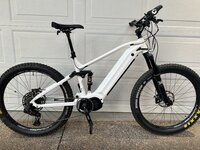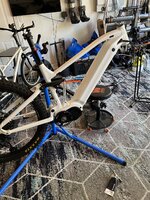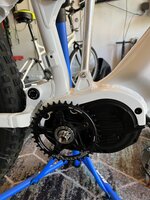Quick Start:
Over the past several months I've had requests to post my settings. I haven't done that for the obvious reasons that my bike, my setup (ludicrious congroller, EggRider), myself, and how/where I ride are almost certainly different than anyone else here. For instance, I suspect almost no-one is using the double-magnet fake-out I outlined in the SPD Table thread to gain a wider range of settable values because I think EggRider might be the only display that supports the necessary double wheel circumference entry (unless you're willing to have your display read MPHs as half of what they really are, which seems equally unlikely).
But, I do get that going through all the threads and figuring out what to do for your own setup is perhaps more time consuming than some are willing/able to put in. And, perhaps it wouldn't be bad to have a starting point from which you can do your own iterating. So, in that spirit, here are some TL;DR summaries (note that any value I don't post just leave at the factory default):
1) Basic Tab:
• Set Limited Speed (%) to 100 for all
• Set Limited Current (%) as follows
| Level | Value |
|---|
0 | 2 |
1 | 10 |
2 | 13 |
3 | 18 |
4 | 24 |
5 | 32 |
6 | 42 |
7 | 57 |
8 | 76 |
9 | 100 |
If, when you try the above, it feels too powerful, the use the values starting at 7 for level 1 in my thread on the Basic Tab. You still end up at 100 for level 9, but the lower PAS levels assist less so when you want you get more of a workout compared to the settings in the Basic Tab Thred. This probably varies the most with how powerful your Ultra controller is. The default for 52v systems is about 1500 watts, but 1000, 2000 and even 2500 watt controllers using UART were out there. If you're on a 48v/1000 watt system you might want more than 10% for level 1. Again, see the Basic Tab thread for the math on how to set that up.
The numbers above, and the math in the Basic Tab Thread are setup to have a uniform percentage increase in power at each level (or every other level if you're on 5 choice in your display). I feel strongly this is a much better feel than spacing values out evenly. But, of coruse, you can just tweak individual amounts in the above table to suit you, using this as a starting point.
2) Pedal Assist Tab:
• Leave all values at default. Most don't matter and the ones that do matter need to be where they're at by default.
3) Throttle Tab:
• See the BBSxx threads as the Ultra appears to work the same. I've got little to add here.
4) Delta Voltage Table on the Torque Tab:
• Set Base Voltage(mV) to 760
• Set "0 Speed Boost Time(x10ms)" to 120
• Set the following values for the table, choosing
either column #2 or #3. Column #2 has a more progressive torque curve, which gives more power at lower torque levels, but even column #3's values are pretty progressive:
| Base Voltage: | 275%/158%/117%/100%,etc. | 175%/150%/125%/100%, etc. |
|---|
| 0-5 Kg | 575 | 366 |
| 5-10 Kg | 331 | 313 |
| 10-15Kg | 245 | 261 |
| 15-20 Kg | 209 | 209 |
| 20-30 Kg | 418 | 417 |
| 30-40 Kg | 382 | 365 |
| 40-50 Kg | 295 | 313 |
| 50-60 Kg | 50 | 260 |
One attribute of Column 2 is that by 50kg of pedal force you're pretty much maxed out as to how much power you can get at the current PAS level and current bike speed. I did that because getting more than 50kg is a LOT of effort that I've decided in my old age isn't somewhere I regularly want to go. 50kg is still a pretty respectable pedal force. Lighter riders or weaker riders might want to max out at 45 or even 40kg. See the thread on the Delta Voltage Table for details on how to do that and still get the max power range out of your Ultra.
5) SPDxx Table on the Torque Tab:
| Parameter | Spd0 | Spd20 | Spd40 | Spd60 | Spd80 | Spd100 |
|---|
| Bike Speed Range | 0 - 3 MPH | 1.5 - 5 MPH | 4 - 8 MPH | 6 - 11 MPH | 10 - 15 MPH | > 15 MPH |
| Start (kg) | 13 | 11 | 8 | 6 | 4 | 1 |
| Full (kg) | 40 | 50 | 60 | 50 | 45 | 25 |
| MinCur (%) | 1 | 3 | 5 | 7 | 9 | 12 |
| MaxCur (%) | 100 | 100 | 100 | 100 | 100 | 100 |
Now the SPDxx table is the place where you need to think about what you're doing on your bike at various speeds. Remember, the SPDxx table columns are based on road speed (actually wheel rpm, but for Ultra bike wheels these are good values). Note that the speed ranges overlap - the Ultra controller feathers the values between the columns at intermediate speeds. For instance, at 7MPH you get about mid-way between Spd40's and Spd60's values.
Note also that anything above 15 MPH and you're in Spd100 alone territory. That may be fine for some off-road riders, but I suspect many on-road riders will go well beyond 20MPH, and you may want different responsiveness from your motor at 28 MPH than at 16 MPH. That's why I do the double-magnet fake-out thing. But, you'll have to actually read the thread on on SPDxx Tables to get that.
My point here is that you should think about what you want from the motor when you're at different speeds, which means thinking about what situations you're in at the different speeds. For instance, SPD0 is done by 3MPH, so for me that's really a start from a stand-still column. So, I'm OK with needing 13kg of force on the pedal (maxes out at 60, btw) to get motor output, but I want the take-off to be smooth, so I start with MinCur at 1%. I also want to get moving, so when I reach 40kg I'm getting the 100% MaxCur, which means I don't have to stomp on the pedal to get full power (within my PAS level) to get going.
SPD20 is similarly mostly a start-up thing for on-road. For off-road you might be doing something technical uphill. Either way, you want controllability here, so having the pedal force range go up to 50 seems right, and no need to have ultra-low power, so I bumped MinCur to 3 (probably could bump it up even more).
Spd40 and Spd60 are pretty similar in these lowish speeds. I pretty much want to reserve full power from the motor for full pedal pressure, and similarly lower the minimum pressure to get power so I get nice pedal pressure to motor output torque mapping.
At SPD80 you're moving along at a decent clip and you either want to stay here or accelerate. So the settings are a compromise between a smooth mapping and lowering ultimate pressure to go even faster.
And finally at SPD100, you probably want to be going even faster. So, lower the Full pedal pressure amount to something easily achievable, which means you don't need to push as hard to get max power output.
Now, to be honest, I haven't done a lot of testing with these SPD values since I personally use the double-magnet fake-out. But, these are pretty close to the settings my wife's bike has (she doesn't like the EggRider) and she's happy with them. YMMWCV (Your Mileage Will Certainly Vary).
Hope this helps - happy Ebiking!

 forums.electricbikereview.com
forums.electricbikereview.com

 forums.electricbikereview.com
forums.electricbikereview.com



